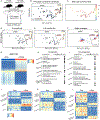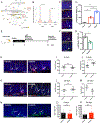Early stem cell aging in the mature brain
- PMID: 33848469
- PMCID: PMC10069280
- DOI: 10.1016/j.stem.2021.03.018
Early stem cell aging in the mature brain
Abstract
Stem cell dysfunction drives many age-related disorders. Identifying mechanisms that initially compromise stem cell behavior represent early targets to promote tissue function later in life. Here, we pinpoint multiple factors that disrupt neural stem cell (NSC) behavior in the adult hippocampus. Clonal tracing showed that NSCs exhibit asynchronous depletion by identifying short-term NSCs (ST-NSCs) and long-term NSCs (LT-NSCs). ST-NSCs divide rapidly to generate neurons and deplete in the young brain. Meanwhile, multipotent LT-NSCs are maintained for months but are pushed out of homeostasis by lengthening quiescence. Single-cell transcriptome analysis of deep NSC quiescence revealed several hallmarks of molecular aging in the mature brain and identified tyrosine-protein kinase Abl1 as an NSC aging factor. Treatment with the Abl inhibitor imatinib increased NSC activation without impairing NSC maintenance in the middle-aged brain. Our study indicates that hippocampal NSCs are particularly vulnerable and adaptable to cellular aging.
Keywords: Abl; Imatinib; adult neurogenesis; aging; bioinformatics; cell fate; clonal analysis; hippocampus; intervention; proliferation; quiescence; single cell RNA-seq; stem cell.
Copyright © 2021 Elsevier Inc. All rights reserved.
Conflict of interest statement
Declaration of interests The authors declare no competing interests.
Figures




Comment in
-
The future belongs to those who prepare for it today.Cell Stem Cell. 2021 May 6;28(5):783-785. doi: 10.1016/j.stem.2021.04.014. Cell Stem Cell. 2021. PMID: 33961757
References
-
- Ahn S, and Joyner AL (2005). In vivo analysis of quiescent adult neural stem cells responding to Sonic hedgehog. Nature 437, 1–4. - PubMed
-
- Alexa A, Rahnenfuhrer J, and Lengauer T (2006). Improved scoring of functional groups from gene expression data by decorrelating GO graph structure. Bioinformatics 22, 1600–1607. - PubMed
Publication types
MeSH terms
Grants and funding
LinkOut - more resources
Full Text Sources
Other Literature Sources
Molecular Biology Databases
Miscellaneous

